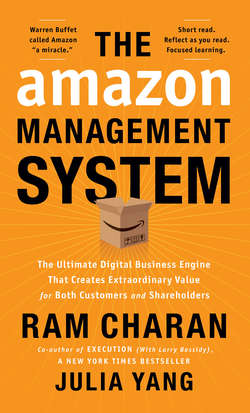Читать книгу The Amazon Management System - Ram Charan - Страница 30
На сайте Литреса книга снята с продажи.
3.0: Unstore — online platform
ОглавлениеWhat’s a platform and how is it different from a store?
A first party selling business is a store, and would not qualify as a platform. A platform engages multiple parties, facilitates complicated transactions and/or interactions with multiple products and services, and creates value for all parties involved.
To have Amazon truly become a platform, Bezos coined the concept of the “unstore,” in order to reframe the notion of Amazon to those who saw it as merely a retailer that had set up shop in a digital zip code. He repeatedly explained and elaborated on why Amazon is a technology company, not a retailer. He argued that Amazon should only concern itself with what is best for the customers, helping them to make the best choices.
This decision would have enormous operational and strategic implications. Amazon would not be bound by traditional retail rules, and, more importantly, would center its efforts on how to build long-term trust-based relationships with customers, instead of how to maximize short-term revenue and profits through its first-party sales.
That’s why after two failed attempts to attract third-party sellers (both launched in 1999, Amazon Auctions abandoned in 2000, and ZShops abandoned in 2007), Amazon audaciously launched the Marketplace, an e-commerce platform owned and operated by Amazon that enables third-party sellers to sell new or used products alongside Amazon’s regular offerings.
In the beginning, many people were baffled by Amazon’s decision to list search results of items from first-party and third-party sellers on the same page, to empower third-party sellers with all kinds of powerful analytical and management tools, and even to share with them Amazon’s own customer base and core competencies, such as fulfillment.
To anyone who would view Amazon’s business model as an online store, its generous offerings to third-party sellers seemed totally insane. Why help your competitors? And yet, to anyone who sees Amazon as a platform, the choice totally makes sense. Because in the platform model, third-party sellers are not competitors, but valuable ecosystem partners. Amazon has built an ecosystem of millions of small and medium-sized businesses, third-party sellers, developers, delivery service providers and authors. 5
By oneself alone, one can never build a platform; by working together with ecosystem partners, a platform will emerge, develop and gradually flourish with a booming ecosystem attached. That’s one of the critical new laws of the game in the digital age. Amazon had the prescience to recognize the dynamic business models increasingly possible under the laws of the digital economy; and created unimaginable value by having these insights early enough to act on them boldly and accelerate the benefits of their interrelated aspects.
Amazon’s famous flywheel (shown below) visually and vividly illustrates the inner logic of how a platform works.
As a standalone online store, one can offer only so many items and serve so many customers, and essentially grow in a linear manner. The platform business model opens everything up for third-party sellers, who trigger growth of a higher order—a jump from linear to exponential, Newtonian to quantum.
More sellers will bring in more selection, attract more customers (i.e., traffic), and thus increase scale (i.e., growth). Increased scale will further reduce cost structure, and will translate into even lower prices for the customers. With increase in selection, decrease in price and likely improvement of convenience (another side benefit of increased scale), the customer experience will be enhanced. The enhanced customer experience will generate more traffic, thus further driving the growth of a powerful flywheel.
This is exactly the innate beauty of platform. All Amazon’s generous offerings to and strong empowerment of third-party sellers, its partners within the ecosystem, are the self-reinforcing mechanism for the long-term growth and prosperity of Amazon’s platform.
By 2018, Amazon had become the biggest online sales platform with 45% share in the US (as shown below). Third-party selling achieved a staggering 52% compound annual sales growth rate, and grew from $0.1Bn in 1999 to $160Bn in 2018.6 Bezos joked in the 2018 Letter to Shareholders, “The percentages represent the share of physical gross merchandise sales sold on Amazon by independent third-party sellers – mostly small- and medium-sized businesses – as opposed to Amazon retail’s own first party sales. Third-party sales have grown from 3% of the total to 58%. To put it bluntly: Third-party sellers are kicking our first party butt. Badly.”
